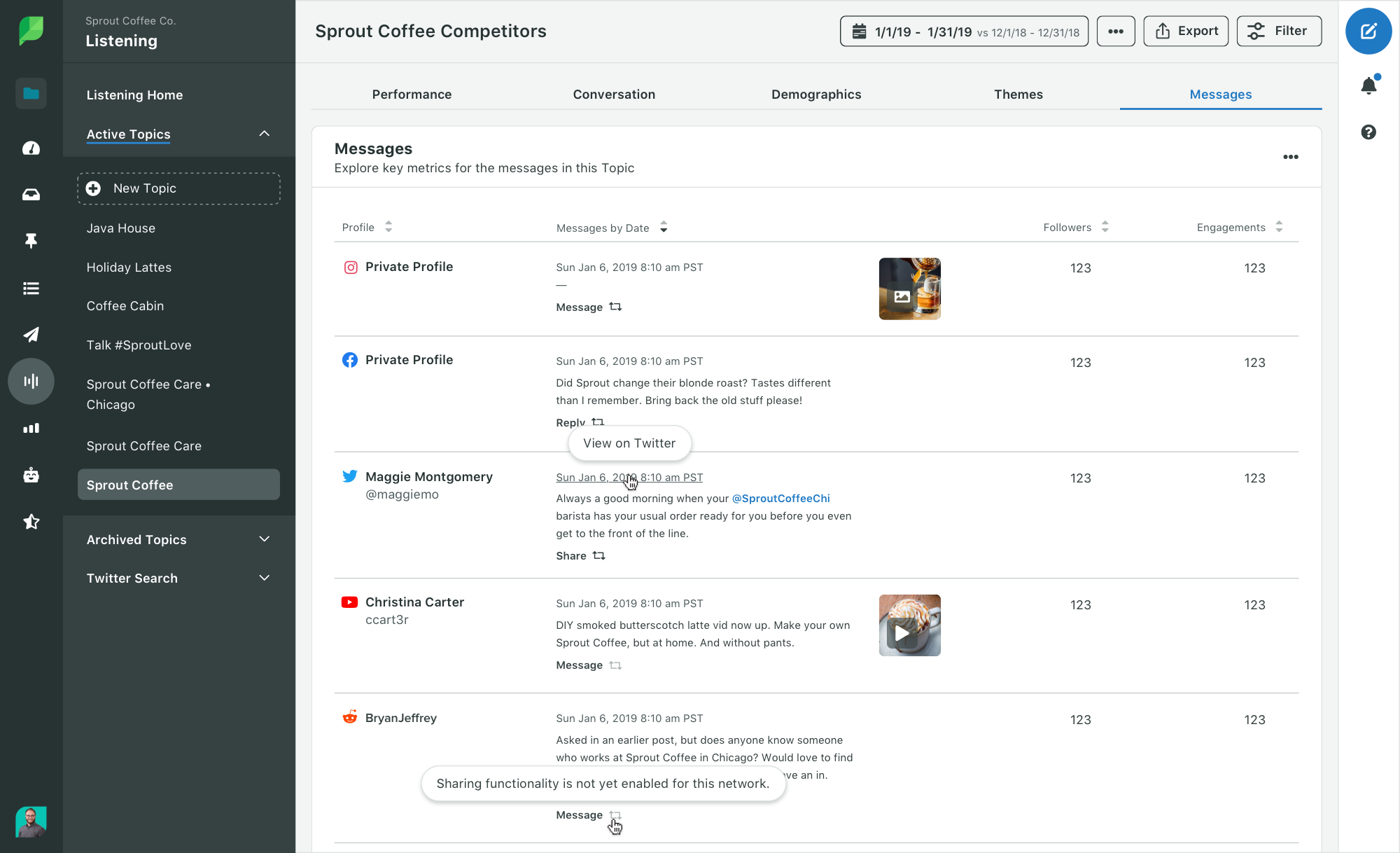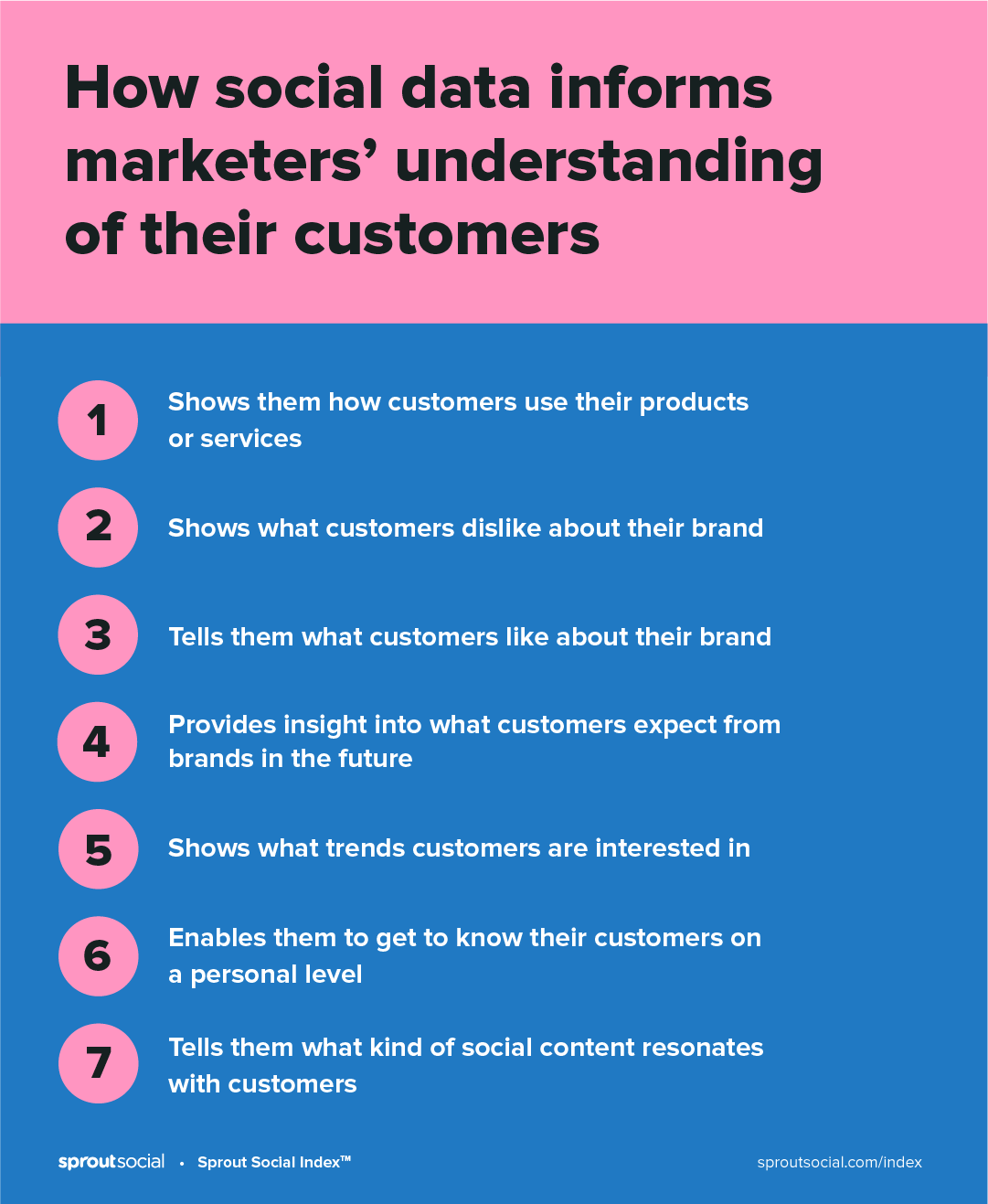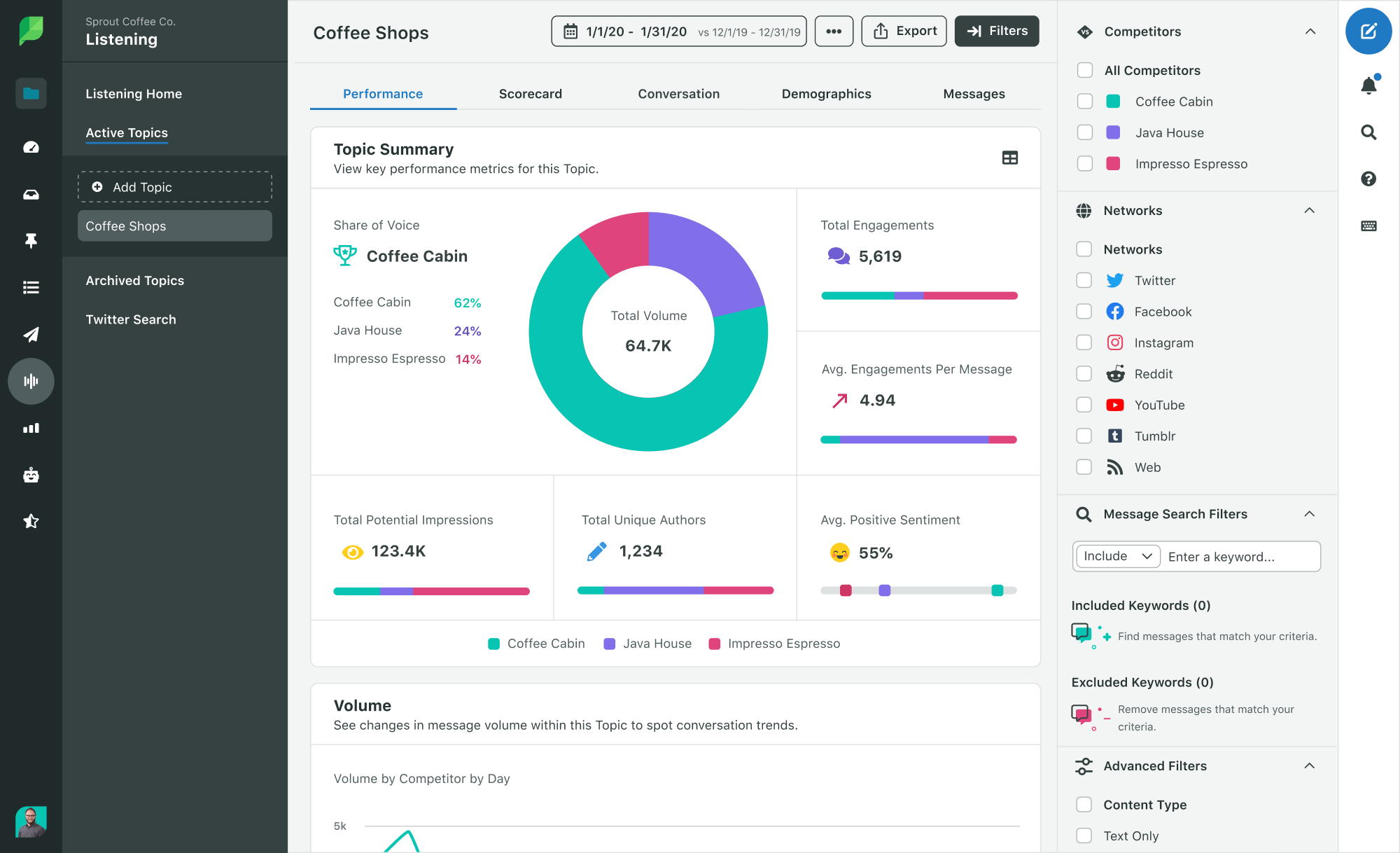As marketers, it’s our job to know our target audience’s needs and preferences. It’s why we conduct market research every year to better understand what our customers want and uncover new business opportunities.
But sometimes market research alone isn’t enough, especially when consumer preferences can change overnight. While focus groups are helpful to reference at the start of new product or campaign development, they’re less useful for gathering customer feedback once said post-launch. And annual surveys reveal little about what current events or trending topics are most relevant among consumers right now. To stay on top of the latest trends and maintain a more accurate pulse on your audience, you need to incorporate social media market research into your strategy.
What is social media market research?
Social media market research is the practice of gathering historical and real-time data from social media channels to better understand your brand’s target market. While it’s possible to conduct market research natively on social platforms, tools like Sprout Social enable you to collect and analyze information from all of your brand’s social accounts in one centralized platform.

Social media market research is also:
- Affordable. Social media is much cheaper than surveys or focus groups, which can cost thousands of dollars depending on the size and complexity of your research panel.
- Quick. While traditional market research methods can take time, social media is always updating in real-time and you can pull existing social data for immediate results.
- Comprehensive. With over 3.6 billion social users in 2020, there’s no shortage of data on social media and tools like social listening make it easy to analyze conversations and trends around your entire industry, not just your brand.
7 market research insights you can get from social media
According to the latest Sprout Social Index™, there are seven unique consumer insights marketers can gather from their brand’s social platforms to apply toward their strategies. Below, we’ll break down all seven social media market research examples and how to find this information on your brand’s social channels.

1. See how customers use your products or services
Tried @weareomsom tonight for the first time. It was delicious and pretty idiot proof.
Instructions:
1. Cook fish
2. Add sauce & cook more
3. Eat pic.twitter.com/6ZMmf7XsmA— Greg Baroth (@gbaroth) July 12, 2021
Consumers aren’t shy about sharing how they use certain products and will rush to share their thoughts on social media. Omsom, a company that creates pantry shortcuts for specific Asian dishes, is regularly tagged in consumer reviews and photos of people’s home cooked meals. In one Tweet, a customer shares how they use Omsom to jazz up their leftovers while another attributes a successful dinner to the Asian pantry shortcut.
How to find this information: When customers want you to know something, they won’t hesitate to tag or mention your brand. Search for your brand and the name of your product on social platforms like Twitter or Instagram to learn how customers actually use your goods and services. Reddit is another treasure trove filled with conversations and communities relevant to your brand or products. And with a tool like Sprout Social, you can easily monitor those branded keywords and phrases to stay up to date with what customers have to say.
2. Learn what customers dislike about your brand
I don't like the way @netflix skips the credits.
— toastfundraiser (@ToastFundraiser) August 13, 2021
One guarantee of any social platform is you can always find someone who dislikes something about your brand, product or service. In the example above, an individual shares a specific feature that forces viewers to skip the end credits of a film or TV show. Even if they’re tough to digest, the negative comments can actually help brands identify areas for improvement to strengthen their offerings.
How to find this information: Truth be told, you probably don’t need to search too hard to find what people dislike about your brand or your products. Beyond searching for branded keywords and phrases, consider checking your social inbox for direct messages that contain constructive criticism. This is also a great opportunity for social teams to solicit feedback from sales or customer service teams who hear directly from customers about their likes and dislikes.
3. Discover what customers like about your brand
Even after spending 6 hours waiting to leave Pensacola, I still love @SouthwestAir. They’re the best airline, even in crisis mode!
— Dr. Erica M. Stone (she/her) (@ericamstone) August 16, 2021
As fast as people are to point out what they dislike about a brand, they’re just as quick to heap praise on the businesses they love. Travelers, for example, may have a favorite airline and are eager to share what makes them a frequent flier of one airline over another. For brands, this is also an opportunity to learn more about what attracts customers to your competitors. If you notice customers can’t stop praising the competition’s exceptional customer service on social, consider reevaluating your own service efforts to find potential opportunities for improvement.
How to find this information: There are several ways you can find positive feedback about your brand. You can search for branded keywords and phrases organically on social; you can also peruse the reviews section on platforms like Facebook, TripAdvisor and Google. In addition to monitoring the conversation around your brand, you should also keep a pulse on what consumers are saying about your competitors. With Sprout’s Listening tool, you can easily set up a competitive analysis report to better track and understand consumers’ attitudes toward the competition.

4. Gain insight into what customers expect from your brand in the future
Hint hint feature request @SproutSocial
— ? Brittnee ? (@BrittneeCoomer) August 3, 2021
Consumers frequently take to social to share what they want to see from brands in the future. A brick-and-mortar retailer might receive a request for a future store location while a coffee company might see comments asking for a specific roast or drink to come back on the menu. At Sprout, we often field Tweets from customers with new feature requests which we pass along to our product team for consideration down the road.
How to find this information: One place where you’re likely to find customer feedback is right in your inbox. With Sprout’s tagging capabilities, you can even label and sort messages by type as they come through, making it easy to pass along product requests to the appropriate teams. Another way to solicit feedback around what customers want to see from your brand is to simply ask. You’d be surprised how many people respond to a question published on Twitter, LinkedIn and Facebook with their thoughts and ideas.
5. See what trends customers are interested in
General Mills is trying to target my childhood nostalgia! There is Dunkaroos and Pokémon cereal now. pic.twitter.com/VWrYyt0cKp
— Lexi Birmingham (@LexiBirmWX) January 22, 2021
As volatile as they may be, trends have a significant impact on a brand’s social strategy and how they connect with their audience. Jumping on the right trending topic at the right time on social can be a jolt to brand awareness and customer engagement. Nostalgia marketing, for example, is a rising trend among consumers and big name brands like General Mills are capitalizing on people’s desire for a childhood throwback in their latest campaigns.
How to find this information: To quickly see what’s trending, check out the explore tab on platforms like Twitter and YouTube or use a tool like Google Trends to see what topics are gaining traction. You can also use Sprout’s listening tool to identify trends within your industry and topics most relevant to your customers. With listening, you can uncover keywords and terms most commonly used by your target audience and discover related topics frequently mentioned with any terms you’re currently tracking.

6. Get to know your customers on a personal level
soo Peloton, what milestones are we celebrating this week?
— Peloton (@onepeloton) July 5, 2021
The beauty of social media is it encourages two-way conversations between brands and their customers, giving brands an opportunity to get to know their audience on an individual level. Facebook communities, for example, provide consumers a space to get to know one another, celebrate personal milestones or share challenges. Peloton is known for curating massive communities where riders can find support and motivation from peers, while Peloton gets to learn a little more about the people who make up their audience.
How to find this information: To get to know your audience better, consider building out your community management strategy on platforms like Instagram or Reddit to stay connected with your customers. Give your customers a reason to engage with your brand by responding to their questions or posting topics for conversation. To help nurture those relationships with your audience further, Sprout’s social media engagement tools ensure you never miss a message from someone in your community.
7. Pinpoint what social content resonates with your audience
Which topic would you be most interested in seeing social listening insights about?
— Sprout Social (@SproutSocial) July 21, 2021
With millions (if not billions) of posts publishing on social daily, brands need to be strategic about what content they post in order to capture their audience’s attention. Take stock of your existing content to see what themes or content formats fuel your performance goals. If video in-feed posts garner more impressions than text posts and raising awareness is your top goal, consider investing more in video production. Or, if you want to drive conversation, look at what posts with high engagement (e.g., comments and shares) have in common. Finally, it never hurts to ask your audience directly what topics or social content they want to see from your brand in the future.
How to find this information: To find the content that resonates strongest with your audience, start by looking at the native analytics and data report tabs per social channel. Sprout’s Post Performance Report helps you break down the types of content you’ve published and identify which performed the best. For more granular insights, you can sort by impressions, engagement and clicks to determine what formats and themes are most effective on specific networks.

Better research starts with social
The best marketing campaigns are the ones that show a brand really gets its audience. When brands demonstrate they understand their customers’ wants and needs, they stand to strengthen their bottom line and develop customers for life.
Thanks to social media marketing research, brands have access to fast and reliable insights that deepen their understanding of what makes their audience tick. From identifying new opportunities to improving customer relationships, data from social empowers brands to make smarter decisions that contribute to their business goals.
Ready to turn your social data into valuable insights about your industry and customers? Download this worksheet to learn how to conduct quick and valuable market research in under 90 minutes.
The post 7 ways to use social media for market research appeared first on Sprout Social.